












keeping you informed.
The Mississaugas of the Credit First Nation are the latest party to apply as an intervenor in Six Nations’ long-standing land-rights case against the Crown.

The First Nation is ap plying to be a plaintiff in what could be the biggest land claim lawsuit settle ment in Canadian history.
The suit seeks answers to what happened to Six Nations land along the Grand River and any mon ies or proceeds the gov ernment obtained from those land transactions.
MCFN now joins the Haudenosaunee Devel opment Institute (HDI) in becoming the latest addition to the court case against the federal and provincial governments,

which Six Nations of the Grand River Elected Coun cil filed in 1995.
Lonny Bomberry, a for mer lawyer and director of Six Nations Lands and Resources, says the inter venors are applying out of pure “greed.”
MCFN did not respond to requests for comment by press time.
The massive land rights case could be the biggest land claim settlement in Canadian history, with some estimates putting the dollar amount in the trillions, and is expected to be heard sometime in 2024. The case was supposed to be heard in September 2022, and was pushed to 2023, and will now be heard in 2024, according to Bomberry, who said the province of Ontario is not equipped to defend its position in the case.
The intervenors are expected to present their case at a superior court in Toronto in April 2023, said Bomberry.
He said SNGR elected council will “vigorously” defend its position as the sole plaintiff in the land rights case, which seeks an accounting of lands the Crown granted to the “Mo hawks and such others” as part of the Haldimand Proclamation of 1784, consisting of six miles on either side of the Grand River from its mouth to source.
Any amount awarded to Six Nations, he said, would be for the benefit of all the people in the community, not just elected council.

The HDI applied in September to be an inter venor (another plaintiff) in the case, citing the Haudenosaunee Confeder acy Chiefs Council (HCCC)
as the true governing body of Six Nations and all Haudenosaunee people in both Canada and the United States.
Bomberry said the case is more of a monetary ac
counting case rather than a land claim case, as Six Nations seeks an account ing of monies associated with the sales and leases of its land without its consent.
MCFN is claiming it did not surrender any land within its treaty territo ries in certain parts of On tario, which includes land within the Haldimand Deed area, said Bomberry.
Kawennio/Gaweniyo lan guage immersion school is chronically underfunded in operations and mainte nance.
The school has to run a deficit just to cover its rent, Six Nations of the Grand River Elected Coun cil’s finance committee heard.

“It’s really threatening to run an organization when it’s so insecure like that,” said Ruby Jacobs, chair of the Kawennio/ Gaweniyo board.
She asked elected coun cil if it would establish an annual budget to fund the school’s operations and maintenance.
“This has been going on for years and years,” she said. “We can’t seem to establish an annual fund ing budget. This has been very difficult for us.”





Kawennio/Gaweniyo is a privately-run Mohawk and Cayuga language im
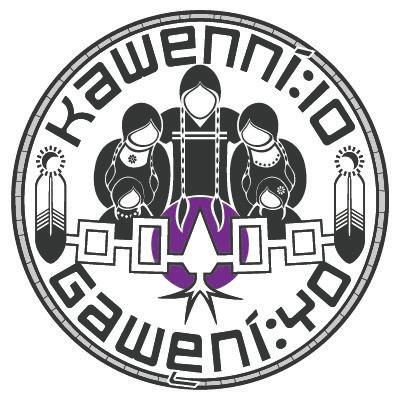
mersion school that was created about 30 years ago. It has never had its own permanent building and currently rents space at the Iroquois Lacrosse Arena.

They’re looking to build their own school at a cost of around $30 million but they’re short of funds.

Board member Ar nold Jacobs said every year it’s a struggle to get operations funding for the school.
“Thirty years is long enough to go through the motions of being unstable for us. We need something solidified, like yesterday.”
The school cost $3.9 million to run last year.
“We would like our funding identified clearly on an annual basis,” Ruby said. "It’s been a rocky road trying to find our budget every year.”
Jessica Bomberry, the new executive director of Kawennio/Gaweniyo, said the bank is asking them for a letter from council guaranteeing they’ll get enough funding to cover
their expenses as they operate in a deficit.



She also said the school had a meeting with Indig enous Services Canada and they learned that funding is determined per
square foot.

She asked if they could include the floor space at the ILA, and even the facilities at Dajoh, where students go every day, as part of their square foot
age in order to get more funding.
“The amount we’re getting from o and m isn’t enough to cover our rent at ILA,” she said, adding that ISC encouraged them
to re-calculate their floor space.
Public Works Director Micheal Montour said fed eral schools on Six Nations are funded at $75 per square meter, but they’re still left with a shortfall up to $500,000 every year.
“For the most part, they’ve been able to adjust at the end of the year,” he said. I would encourage you to figure out what you use at ILA, even the entrance way. If you need support, I’m happy to support, as well.”
He said his department would assist with the measurements.
Bomberry said the school currently gets about $40,000 a year for operations and mainte nance, but the it costs about $5,000 a month for rent, so they’re already short at the beginning of the year,.
Jacobs said an update on the Kawennio/Gaweni yo school build funding is coming on Nov. 15.
She was awarded Canada’s highest honour during the pandemic and last week, Mississaugas of the Credit First Nation elder and esteemed commu nity member, volunteer and knowledge keeper received her Order of Canada medal in person at a special ceremony at Rideau Hall in Ottawa.
King, who is known for her years of volunteerism, advocacy for her people, and ambitious, Ontar io-wide Moccasin Identi fier project, was named to the Order in 2021.
She received the presti gious award in person last week in Ottawa.
King, who was the first female Chief of Missis saugas of the Credit First Nation, joins Justice Harry Laforme, and Pat Mandy, former chair of the College of Nurses of Ontario, to become the third person in the small community to receive one of the coun try’s top honours.








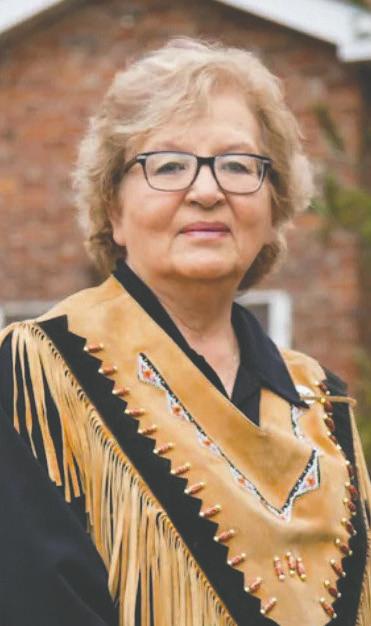
King was awarded the honour for her expertise in community develop ment, her advocacy of Indigenous-led initiatives, and her efforts to improve Canada’s understanding of First Nations.

King told the Two Row Times she was surprised to find out she was ap pointed to the Order of Canada when she got the called in early Decem ber from Rideau Hall in Ottawa.
“It was amazing. I was surprised. I felt pretty good about it that people thought I should be hon oured at that level.”
It took numerous phone calls from Rideau Hall to reach King to inform her of the prestigious honour.

“I didn’t call back,” she said. “I was busy with other things.”
Finally, King called back.
“By the third or fourth call, the lady was getting desperate,” said King with a chuckle. “I thought they were calling (for me) to give a recommendation to someone else.”
When Rideau Hall
informed her that she was the one being appointed a member of the Order of Canada, King’s reaction was, “oh my goodness.”

King said she was already honoured at such a high level within her own community, howev er, when she was given an eagle feather at the Mississaugas of the Credit First Nation powwow.



“If you don’t under stand how important it is,” she said, “it’s like your Order of Canada. Now I have both. I get to say that now.”

King has been a busy woman all her life. Constantly involved in community politics and community improvement, King never stops. Whatev er project she starts, she finishes.
“It’s because something needed to get done,” she said. “Somebody needed to do something. It’s the women who take up the work. There was so much to do.”
King was the first female chief of MCFN in the late 90s, serving for
one term before she called it quits in politics. The role prevented her from getting any work done, she said.
King is passionate about community devel opment and is currently in the middle of an ambi tious multi-year project to place “moccasin identifi ers” throughout Southern Ontario. The moccasin identifiers consist of stenciled or carved moc casins at historic places in Ontario with plaques that explain a little bit of the history of the Mississauga people.
King is frequently found on the lecture circuit ed ucating Canadians about Indigenous peoples and their history.
She is also big on build ing relationships with allies across Ontario.
“We need to have good relations with all the people around us to do what we need to do. We couldn’t do it all our selves.”
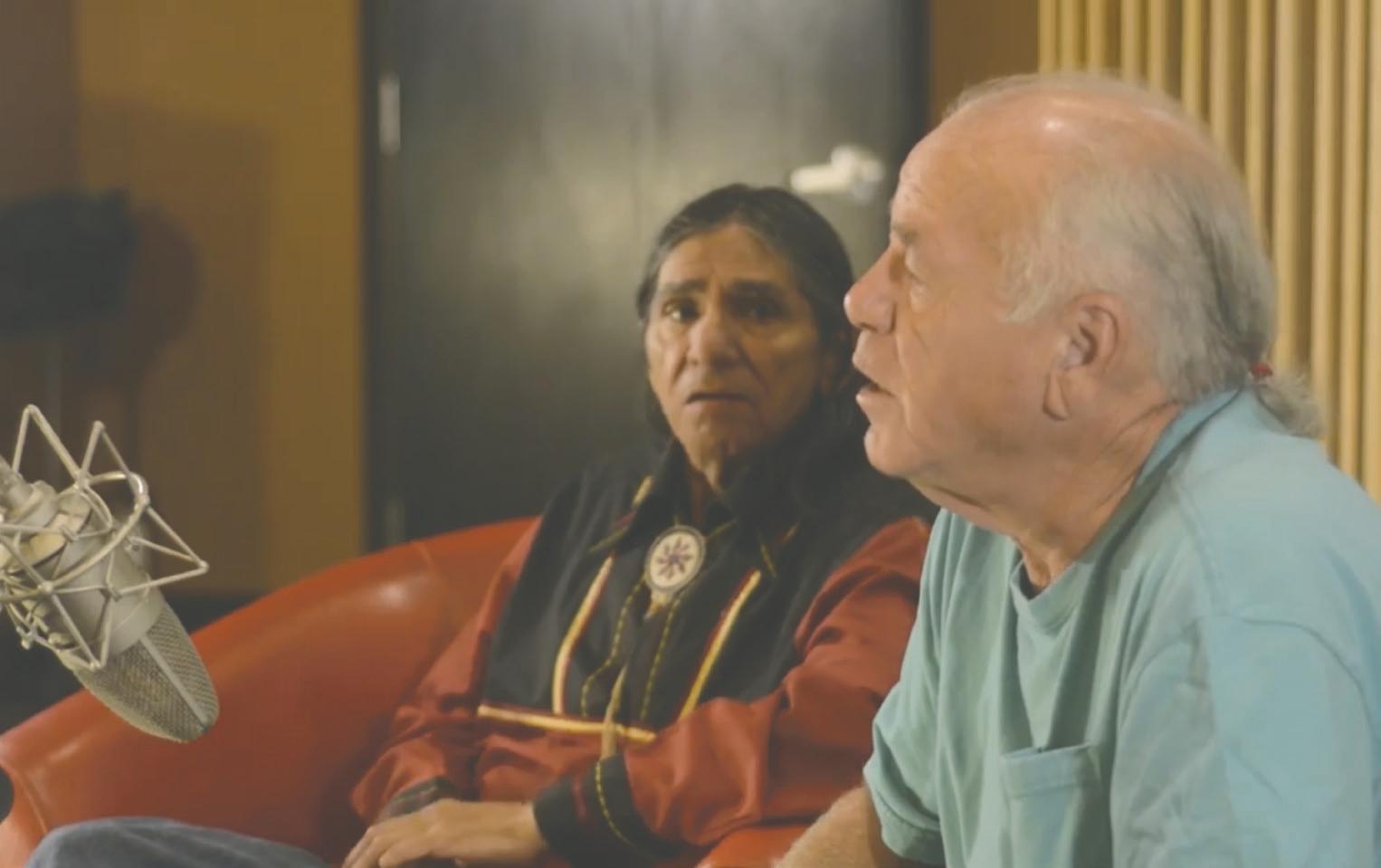 NAHNDA GARLOW nahnda@tworowtimes.com
NAHNDA GARLOW nahnda@tworowtimes.com
SIX NATIONS — A video series produced by Two Row Times, ‘Learning the KAIANEREKOWA — the Great Law of Peace’, has released seven new videos from the series to social media this month examin ing the cultural and political heritage of the Six Nations people.
Jonathan Garlow, publisher of the Two Row Times, produced the video series and has been releasing videos since 2020. Garlow, who is mixed-Mo hawk and Potawatomi and raised at Six Nations, says more are on the way.
“Since filming my docu mentary, ‘Day Zero’, about the 2006 events at Douglas Creek Estates, and even be fore then, I’ve been search ing after the truth about our people’s history. I wanted to know more about the Great Law, and I understood enough to know that we, the people of the Confeder
acy, weren’t being told the full story about our history and how we became a Con federacy. Either at Canadian schools or internally here around the kitchen tables at Six Nations,” said Garlow.
“I had a printed version of the great law and I wanted to know the truth about the great law. Why is there different versions? What is the real great law?”
That truth seeking jour
ney ended up being a five hour teaching day between Garlow, his two-man cam era crew, and Tekarontake and Ateronhiatá:kon — an interview he says was a great experience, person ally.
“I was taken through this incredible journey of laughter, tears and amazement,” said Garlow. “Theres’s something unique about the way they speak,
in some moments their voice — was so powerful. Something rises up within them and you can tell that they are connecting with the ancestors. At times, my hairs were standing up. In this interview I didn’t have an agenda or try to get a certain angle. I wanted the unfiltered truth. So I filmed the experience of transmitting oral tradition from elders to nephews.
I was personally a part of that living story where my genetics play into the whole thing that they are talking about. It was emotional. It was electric.”
What resulted is a beautifully nuanced and politically sophisticated discussion about Haudeno saunee issues and history internal to the people of the Confederacy, some of it done in the Mohawk lan guage — and a perspective that is not often put before the camera. Garlow says this is something important to the political future of Six Nations.
“I should be able to take a critical look in the mirror without getting offended. Some of these items being discussed are very hard to talk about without people getting upset in some way so the fact that we were able to sit for so long and talk about things peacefully is very important. It’s not your boring old surface level history, it runs deep,” said Garlow.
The series was filmed at Jukasa Studios, who do
nated studio space for the project. “I have experience as a documentarian but I still needed a lot of help with the technical aspects,” said Garlow.
Darren Magierowski of Jukasa Studios did the au dio recording, Ian Maracle was the photography direc tor and assistant camera was Wes Day.
“We didn’t have proper lighting. We just brought in every lamp we could find that was at the studio and went with that. It worked out nicely though it brings more of a campfire feel in a way.”
Tekarontake and Ateron hiatá:kon shared that some of the teachings they learned came from elders at Grand River, and that the di alect of Mohawk they speak is an old dialect that comes from the Mohawk Valley.
“These are Grand River teachings come home,” said Garlow.
The video series is available now on the Two Row Times social media accounts and on YouTube.
We are currently looking for a Junior Computer Technician possessing and working towards building technical knowledge in computers, networking, software, problem-solving. A successful candidate should have excellent customer service skills and be physically fit able to lift 40+ lbs.
• Support for Ohsweken Speedway and GSR company’s including but not limited to; Internet Connectivity, Computer and network systems.
• I.T. support for staff computers, business networks, Point of Sale Systems
Troubleshooting various computer/network issues
Perform regular upgrades to ensure systems remain updated
Providing technical support on-site or via phone or email
• Desktop maintenance and repair.
• Experience configuring and maintaining a Windows server environment
• Experience network cabling
Must have a valid Driver’s License and a provide a clean driver’s






Abstract prior to being hired.
Full-time, Permanent
Salary: TBD based on experience/skills.
Please provide resume to: humanresources@gsrcd.com
editor@tworowtimes.com

 NAHNDA GARLOW nahnda@tworowtimes.com
TWO ROW TIMES
NAHNDA GARLOW nahnda@tworowtimes.com
TWO ROW TIMES
One of the less talked about wars that Six Na tions warriors at Grand River participated in was the Upper Canada Rebel lion in 1837-38. During that year of fighting, Six Nations sent some 750 warriors to defend Upper Canada against armed Reformers, led by William Lyon MacKenzie. They were protesting the Fam ily Compact — a group of oligarchs that were doing favours for rich business owners through the gov ernment.
It’s sad to now read back into the history and note that at the same time that 750 Six Nations men were fighting to protect the property and govern ment of those within and around the Family Com pact — people within the Compact were robbing the Six Nations blind.
William Hamilton Merritt, George Keefer and Samuel Jarvis. Remember these names.
These three conspired with one another within that power structure in Upper Canada to steal Six Nations money to build the Welland Canal, the
Grand River Navigation Company, and more to help their investors, family and friends profit unjustly.
It started with the Keefers. George Keefer was a United Empire Loy alist who came to Upper Canada from New Jersey. He is noted in history as the person responsible for flooding Six Nations terri tory along the Grand River during the construction of the Welland Canal.
Hamilton Merritt is notoriously remembered as the colonizer who bankrupted the Six Nation people through the Grand River Navigation Compa ny — a venture looking to build a small East to West canal joining the Welland Canal to improve the transport of goods in Upper Canada.
Jarvis was the Superin tendent of Indian Affairs in Upper Canada at that time. He and Merritt were part of the “Fami ly Compact”, a group of elite Canadian families that helped one another politically and financially to colonize Canada.
In 1832, Merritt sought investors for the Grand River Navigation Compa ny, but could not raise the capital to launch.
His project was op posed by Grand River.
Specifically by John Brant, a Mohawk man and son of Captain Joseph Brant, who was concerned that Haudenosaunee lands and fisheries along the Grand River would be ruined in the construction of the canal.
John Brant ran for an elected seat in the Up per Canadian legislative assembly and won.
Something that drew the ire of Merritt — who had learned that Indig enous voices in politics standing up for land rights were preventing the work of colonizing Upper Canada.
So Merritt took legal action against Brant, to nullify the Indigenous votes that got Brant fairly voted into office under the argument that impover ished Indigenous voters, by law, didn’t own enough assets to count as a voter.
Merritt’s lawsuit was successful, Brant was removed from office and a by-election was called to fill the vacancy.
Brant sought to run again in the by-election but in the meantime, he contracted cholera and died — leaving no strong voice for Six Nations to the government. Merritt ran in the by-election for Haldimand and won,
claiming Brant’s former seat.
Merritt became a majority shareholder in the Grand River Naviga tion Company, along with colonizer David Thomp son — who was a co-in vestor with Merritt in the Welland Canal.
Merritt convinced the Indian Department and Samuel Jarvis to invest Six Nations trust funds into the company. Six Nations historical reports in the Global Solutions accounting of the breach of trust claim against the federal government show that “Between 1834 and 1847, recorded transfers show more than £44,292 ($177,168) was taken from Six Nations Trust Funds by Crown Agents and invested into the Grand River Navigation Company through stock purchases. This was completed contrary to the repeated protests of Six Nations.”
When construction began, the Welland Canal Company guaranteed landholders, including Six Nations, compensation for any lands, homes or struc tures that were destroyed due to flooding during construction of the Canal. Historical records suggest that white landowners
were compensated as agreed but that the Six Nations were not.
According to the Global Solutions land rights accounting, Six Nations claims that $9000 was in vested in the Welland Ca nal project without being repaid — with compound ed interest that is listed as a current day value of $107,743,646,916.
In 1836, Keefer, his sons and Merritt would all be subject to an inquiry for unjust enrichment, nep otism, fraud, neglect and carelessness while they served in leadership as Directors for the Welland Canal.
The Keefer legacy is a case-in-point for how colonizers financially benefitted and passed a legacy of wealth trickling down to their descendants by overtly supporting and enabling the marginaliza tion of Indigenous people in Ontario.
George Keefer success fully colonized what is now Southern Ontario and left a legacy behind for his ten sons and five daugh ters. His financial success at the Welland Canal gave him the affluence to build mills that were fuelled by the power from the canal. He died in 1858 a very rich man, the founder of
the town of Thorold where he built the Keefer family mansion, which today is known as the Keefer Man sion Inn.
His descendants — Thomas Coltrin Keefer and Samuel Keefer — became noted civil engineers in Canada during the 1800s, securing the legacy of col onizing developments in Upper Canada in various other projects such as the building of Upper Canada College, the Cayuga Bridge Company, the Erie and Ontario Railroad Com pany and the Montreal Turnpike Trust and McGill College construction along with other members of the Family Compact group.
Interesting to note is those same projects acquired investment by the Crown from Indian Agents from Six Nations trust with no repayment.
McGill College received an investment translat ing to $95,772,130,592 and the Erie & Ontar io Railroad Company investment now sits at $105,349,343,651.
A shocking $113,600 was invested in the Montreal Turnpike with no return to Six Nations, a system designed by Thomas Coltrin Keef er. That translates into $697,876,697,563 today.
Make advertising cheques payable to:

Garlow Media
Oneida Business Park Suite 124
50 Generations Drive, Box 1 Ohsweken, ON N0A 1M0
Thank you for your advertising support!
Publisher:
Website Manager: Benjamin Doolittle Senior Writer: Jim Windle Columnist: Rachel A. Snow Writer: Jace Koblun
Advertising Sales Co-ordinator: Marshall Lank Advertising Sales Executive: Christine Patton Advertising Sales Executive: Ashley Smith
Distribution Manager: Tim Reynolds Brantford Distribution: Christian Kovac
Main office: (519) 900-5535 Editorial line: (519) 900-6241 Advertising line: (519) 900-6373
For advertising information: ads@tworowtimes.com General inquiries: info@tworowtimes.com Website: www.tworowtimes.com
World Diabetes Day (WDD) was created in 1991 by the International Diabetes Federation (IDF) and the World Health Organization in response to growing concerns about the escalat ing health threat posed by diabetes.



WDD is marked ev ery year on Nov. 14, the birthday of Sir Frederick Banting, who co-discovered insulin along with Charles Best in 1922. Every year, the WDD campaign focuses on a dedicated theme that runs for one or more years. The theme for World Dia betes Day 2021 to 2023 is Access to Diabetes Care.
“Canada's Indigenous populations continuously demonstrate great strength and resilience. However, these communities face greater health challenges than most, including an increased risk of develop ing type 2 diabetes,” says diabetes.ca. “This is a result of several overlapping and compounded factors, including Canada’s historic and continued colonial policies, such as residential schools, Indian hospitals, and the sixties scoop; lack of access to healthy, nutri tious, and affordable food; and a strong genetic risk for type 2 diabetes.”

These factors have undermined Indigenous values, culture, and spiritu al practices, while creating lasting physical, mental, emotional, and social harms for these commu nities. Here’s a snapshot of the age-standardized prevalence rates of type 1 and type 2 diabetes.
“In Canada, age-stan dardized prevalence rates for diabetes are 17.2 per cent among First Nations individuals living on-re serve, 10.3 per cent among First Nations individuals living off-reserve, and 7.3 per cent among Métis peo ple, compared to 5 per cent in the general population,” said the Diabetes Canada Clinical Practice Guidelines Expert Committee.
There are several organi zations on Six Nations that
offer services for diabetes patients on the territory.
The Diabetes Wellness Program offered by Six Nations Health Services provides primary care treatment to those living with diabetes as well as creates awareness, pro gramming and provides education on diabetes and its associated risks.
The Diabetes Wellness Program team is comprised of a registered nurse, registered dietitian, social worker, chiropodist, foot care nurse, and administra tive assistant.
The program offers education and support in terms of support groups, education sessions, and community presentations. And wellness activities such as physical activities and cooking classes.
The program offers foot care which is comprised of foot care education, diabetic footsore provided by nursing or chiropody, leg and feet examinations, and foot assessments including, circulation, sensation, and edema (swelling caused by excess fluid trapped in your body's tissues).
Treatment options include, insulin injections, non-insulin injections, oral hypoglycaemic agents, lifestyle management, and diabetes risk assessments. If interested in learning more about the intake or referral process call 519445-2226.
Here are some other ways you can support the WDD initiative.
Support the call to action to policymakers: Send a let ter to your national health minister or Permanent Mis sion to the United Nations in Geneva asking them to dedicate sufficient human
and financial resources to diabetes education to help achieve the World Health Organization (WHO) diabetes coverage targets by 2030.
Promote the blue circle: The blue circle is the global symbol for diabetes awareness and the logo of WDD. There are many ways you can help promote the global symbol of diabetes awareness:
– Wear blue for diabetes.
– Wear the blue circle pin or bracelet (available to buy at worlddiabetesday. org).
– Persuade a Member of Parliament, celebrity, or high-profile individual in your community to wear the blue circle pin. Don’t forget to get a picture.
– Promote the blue circle selfie app.
– Include the blue circle in all of your correspon dence and promotional materials.
– Use the blue circle as your profile picture on Facebook.
Survey on access to di abetes education: To mark World Diabetes Day 2022 the International Diabetes Federation has launched a global survey to explore the levels of access that health care professionals and people living with diabetes have to diabetes education.
“If you are a healthcare professional or a person living with diabetes, we invite you to spare 10 minutes of your time to complete the survey. Your answers will help us inform World Diabetes Day 2022 activities and highlight the importance of accessible and quality diabetes educa tion to protect tomorrow,” states the website, where the survey can be found.




SIX NATIONS — The warriors of the Six Nations Confederacy are not often remembered for their military service during the Upper Canada Rebel lion — but it was a “war” fought on local soil and the military efforts of the people of the Confederacy were critical to its out comes.
The Upper Canada Rebellion of 1837-38 was a number of armed insurrections against the oligarch elites and wealthy business owners that were controlling the govern ment at that time, known as the Family Compact.
Members of the Fam ily Compact were either wealthy business owners or part of an emerging Canadian aristocracy made up of British elites that were doing favours for one another’s busi ness ventures through their part as government officials.
Frustration with the elitist leadership in Upper
Canada grew. There was no system of public accountability in place and the people of Upper Canada started a Reform movement and estab lished political unions to deal with corruption inside the government.
The Reform movement found leadership under William Lyon MacKenzie, a Scot who was also a newspaper publisher. He is credited with organiz ing the reformers and guiding them toward an American Revolution style insurrection that would try to seize control of the government.
Reform gangs went across the country, de stroying the property and homes of people inside the Family Compact. Loyalist militias were formed and were called upon to fight rebels.
Six Nations had a direct role in offering military support to the British as ally force loyalists inside Upper Canada. First Na tions troops were paired with Canadian militias to guard strategic points and waterways, allowing Brit ish Regulars to handle the
more intense battles.
Six Nations warriors were called upon specifi cally by Colonel Allan Mac Nab to patrol and capture fleeing rebels along the Grand River and in Oxford County. In May 1837, prior to the beginning of the conflict — 100 Six Nations troops went with 150 men from the Gore Militia to actively halt pro-rebel meetings in Brantford and to confront Dr. Charles Duncombe and his rebel
force in the small town of Scotland.

Again, in 1838 a total of 250 men from Six Nations, Upper Cayuga and Delaware went to Oakland, Mount Pleasant and Paris to confront another rebel force. They were then called out to Port Dover to defend the shores in October 1839 with 600 men. Brantford’s militia was also called out to defend Port Dover but they refused to go.
The fighting had a massive impact on com munity life at Grand River. Historical documents show that the men were all gone in January 1838 to defend against a rebel army that was taking over Navy Island - where Lyon MacKenzie had set up a separatist headquarters for the Reformers.
Schools were let out of session, including stu dents who were staying at the Mohawk Institute,
because the children were needed at home to make ends meet.
Sadly, the efforts of the men in the 1837-38 rebel lions would not positively impact the future of Six Nations, despite the war riors demonstrating their loyalty to the Crown. Just a few years later in 1841, some of the chiefs of Six Nations would sign onto a land surrender that to this day is used to disinherit the Six Nations people from their lands.
The following Six Na tions Warriors fought as loyalists in the Rebellion of 1837-38
Lieutenant Colonel William Johnson Kerr and Lieutenant Geo. H Kerr. Sergeants William Alvis, Joseph Barefoot. John Buck, Joseph Doxtader, Pe ter Fishcarrier, John Jacob, John S. Johnson, Oneida Joseph, Patrick Latham, Jacob Martin, Noah Powlis, John Styres, Geo. Anthony, Henry Brant, Lawrence David, John Fish, Abraham Hill, Jacob Johnson, Joseph Aughquaga, Kanonhkari tawih, Wiliam Loft, Joseph Martin, Skanawate, Moses Walker.
Aaron, Cayuga Abram, Joseph Aghkarhe Alvis, Joshua Anderson, Corns.
Aneoyowistha Anestokaonks Anthony, Oliver Anthony, Wm. Anyerigh Anyaryaks Aonweajaskenhen Arirhon Aronyaketas Aswahtha Atawakon Atawethas Atonthetha Atonwas Atyaktatye Atyanatha Atyaserone Atyatonneatha, Jns. Aughquaga, Isaac Aughquaga, Joseph, Jr. Aughquaga, Peter Awekah Axe in side Ayenkori Beaver, Geo. Beaver, Jn. Bigdar, Moses Bone, Peter Brant, Seth Bull, Ebenezer Bull, John= Burnham, Jack Burning, Isaac Burning, Nicholas Burning, Thomas Cabbage, John Cannon, Abraham Captain, Silver Carlough, John Carpenter, Abraham Carpenter, David Carpenter, Jacob Carpenter, Joseph Carpenter, Joseph, Jr. Carpenter, Moses Chew, Saml. Claus, John Claus, Joseph Claus, Lawce. Claus, Peter Claus, Thomas Claus, Young Clench, Henry Cobus Coffee, Samuel Coffee, Thomas Commodore Commodore, Jns. Cornelius, Jn. Cornelius, Jn. Crawford, John Crawford, Wm. Cuore, John Curly, Wm. Dagods, John Dakwayanond Dallon, Jn. Dany, Jn. Dany, Peter David, Isaac, Jr. Davids, David Day, David Deaonajanenh Deaonajanenh, Joseph Deghatkathos Dehanonyanitha
Dehatkonwatorens Dehennonsonkotha Dehonwayaserha Dehowatiryah Dehoweakoronte Dekanagwashin Dekayendunhare Dektsirere Delaware, Lewis Dewehanitokea Deyohatighgauh Deyonhohisek Dickson, Isaac Dickson, Wm. Dockson, Peter Doctor, Henry Doctor, Isaac Doctor, Wm. Douglas, Corns. Douglas, Geo. Douglas, Henry Douglas, Jn. Doxtader, John Doxtader, Joseph Doxtader, Wm. Doxtader, Wm. Ennatsera Farmer, David Hill Farmer, John Fish, Jacob Fowler, Samuel Fox, John Fraser, John Fraser, Joseph Fraser, Peter Froman, David Froman, John Funn, Soloman George, David Givens, James Goose, Wm. Grant, Abram Grant, Wm. Grant, Wm., Jr. Green, Aaron Green, Aaron Green, Abraham Green, Daniel Green, Jacob Green, John Green, Joseph Green, Luke Green, Nicholas Green, Peter Green, Peter, Jr. Green, Peter, Senr. Green, Wm. Green, Wm. Haghsennony Haiwaes Hakinhshea Hanojot Hanotyontha Harenkararon Harris, David Harris, Jn. Hatonnas Hattenburg, James Hawennaji Hayonwais Hendrick, Adam Henry, Jacob Henry, Jacob Henry, Jacob, Jr. Henry, Nicholas Henry, Peter Heron, John Hess, David Hess, Joseph Hess, Peter
Hess, Sampson Hess, Sampson, Jr. High�lier Hill, Aaron Hill, Abram Hill, Isaac Hill, Jacob Hill, Jacob, Jr. Hill, James Hill, John Hill, John, Jr. Hill, Joseph Hill, Peter Hill, Seth Hill, Thos. Hill, Wm. Hoghshaestataon Hononhsatekha Honwaneharon Honyarowanin House, Thomas House, Thos. Hoyenkore Hudson, Wm. Huff, Jn. Husk, James Isaac, Jacob Isaac, John Jacket, David Hill Jacob, Wm. Jaken JiJi John, David John, Isaac John, Joseph John, Wm. Johnson, Aaron Johnson, Elijah Johnson, Geo. M. Johnson, Jacob Johnson, Jacob Johnson, Jacob Jr. Johnson, John B. Johnson, Joseph Johnson, Wm. Johnson, Wm. Johnson, Wm. K. Jonathan, Peter Jonkonwat Jordan, Nichs. Joseph, Corns. Kahashenton Kahgwenjiont Kahnatia Kahnyotakwenh Kahyothoyon Kakontinayin Kanasatirhon Kanatakta Kanatiyorha Kanatohare Kaniatayenah Kaningoton Kanonraron Kanonsase Kanutarhon Kanwisakon Kanyakaroton Karaghkontye Karaghyenhgo Salt Karighwaiyah Karighwiyoh, Peter Katakwaason Katinta Kawistanoron Kayentatishen Kick Henry Kick, Isaac Kohkeasheah, Geo. Koronhyakwekon, Wm.
Kowehe Latham, James Lewis, Isaac Lewis, Jacob Lewis, Joseph Lickers, Abraham Lickers, Henry Lickers, John Lickers, Samuel Listarares, Son Lock, Isaac Lock, Jacob Long Fish Long, John Long�ish, Joseph Long�ish, Wm. Lottridge, Joseph Lottridge,Jacob Maracle, Abraham Maracle, Corns. Maracle, David Maracle, Geo. Maracle, Jacob Maracle, John Maracle, Paul Maracle, Seth Maracle, Wm. Marin, Geo., Senr. Martin, Geo., Jr. Martin, Peter Miller, Anthony Moses, Corns. Moses, Jn. Moses, Joseph Mosquitoes Mount, Moses Munture, Geo. Munture, Wm. Nash, Aaron Newhouse, Nicholas Nicholas Nikanatasa Nikanowasa Norton, Peter Notloadia Novakon Obe, John Oghnawakehte Oghnawera Okarweatu Old Sheep Oneida Jacob Oneida Man Onentakenshonah Onondaga, John Onondaga, Moses Ononserakahte Onwaskanekhon Onwayonseh Otarakehte Otrijatekia Otsinonyata Otter, Corns. Otter, Joseph Owl, John Oyatakehte Pamelton, James Paterson, James Peters, John Peters, Wm. Pleasant, Geo. M. Powelis, Abraham Powelis, Guy Powelis, Powelis Powelis, Wm. Powlis, George Powlis, Henry Powlis, James Powlis, John Powlis, Paul
Powlis, Peter Powlis, Peter, Jr. Printup, Adam Raghserohin Rahskanox Raorenon Ratenher Rayasin Rayatyonny Ronjakihte Ronwayenterigh Rotahawihton Royenthon Sage Harry Sagoyatiatha Sahoronyonti Sakoghtyoeh Salt Satihna Sawatis Seneca John Seneca, Adam Seneca, David Seneca, Thomas Sergeant Major Shahitkea Shakakennyonkwas Shakokenanywas Shakokokenyatha Shakotyohgwisaks Shakowaes Shakowighae Shanayeh Sharinhowane Shatekariwate, John Shatikononhyaton Shaw, David Sheephead, Wm. Sheny, Jn. Shogontsewowane Shojijowa Shoninhares Shononyowa Shoro, John Shotohares Shuonweajowane Silver, G. (?) Silver, Jerry Silversmith Skaentowane Skanisatih Skaronyatih Skayanes Skunyatariyo Skyler, John Sleepy Davy Smith, Aaron Smith, Henry Smith, Joel Smith, Nicholas Smith, Peter Smith, Wm. Smith, Wm., Jr. Smoke, John Snake, Geo. Snake, John Snake, Thos. Snow, Lewis Snow, Soghsawetis Soghwasowa Sojijowanea Sononhares Squire, Hamilton Staats, Henry Stump, Jacob Sturgeon, Jacob Sturgeon, Yohhanis Styres, Geo. Styres, John Sugar
Takayengwaraton Tamerane, Isaac Tasenk Taskwayen Tawayo
Tayotekane Tehaontyinlas Tehononhyanihtha Tekaghenwashen Tekanenhsoken Tekayentenhare Teyawentaronwe Teyhatawenrigh Thom, John Thomas, Bill Thomas, D. Oneida Thomas, David Thomas, David Thomas, Docter Thomas, Isaac Thomas, Jacob Thomas, Jacob Thomas, Joseph Thomas, Samuel Thomas, Wm. Tistis
Tom, James Tom, John Tom, John Tom, William Troublesome, David Tsekoreksiriyo Tsigeh
Tsitenah, Peter Tunis, Geo. Turkey, Levi Tuscarora, John Tutulee, Geo. Tutuli, Jn.
Twenty Buttons Wahatiwennokten Wahoennanonon Wahonwaronwas Wahotenenokhas Wahotsigwayoha Wahreahotakon Walker, Moses, Jr. Walker, Wm. Wampum, Jn. Warner, Jn. Warner, Young Watonnons Whitby, Isaac White Oak White, Isaac William, Jacob William, James William, Joshua William, Simon Williams, Jn. Williams, John Wilson, Bull Winens
Winny, Jacob Winny, Wm. Yahtha
Yonah, Jacob Young Chief
Young Chucklehead
Young Davy Young Fishcarrier
Young Goose
Young Haner
Young Hattenburgh
Young Latham
Young Silversmith
Young William
Source: Six Nations Legacy Consortium
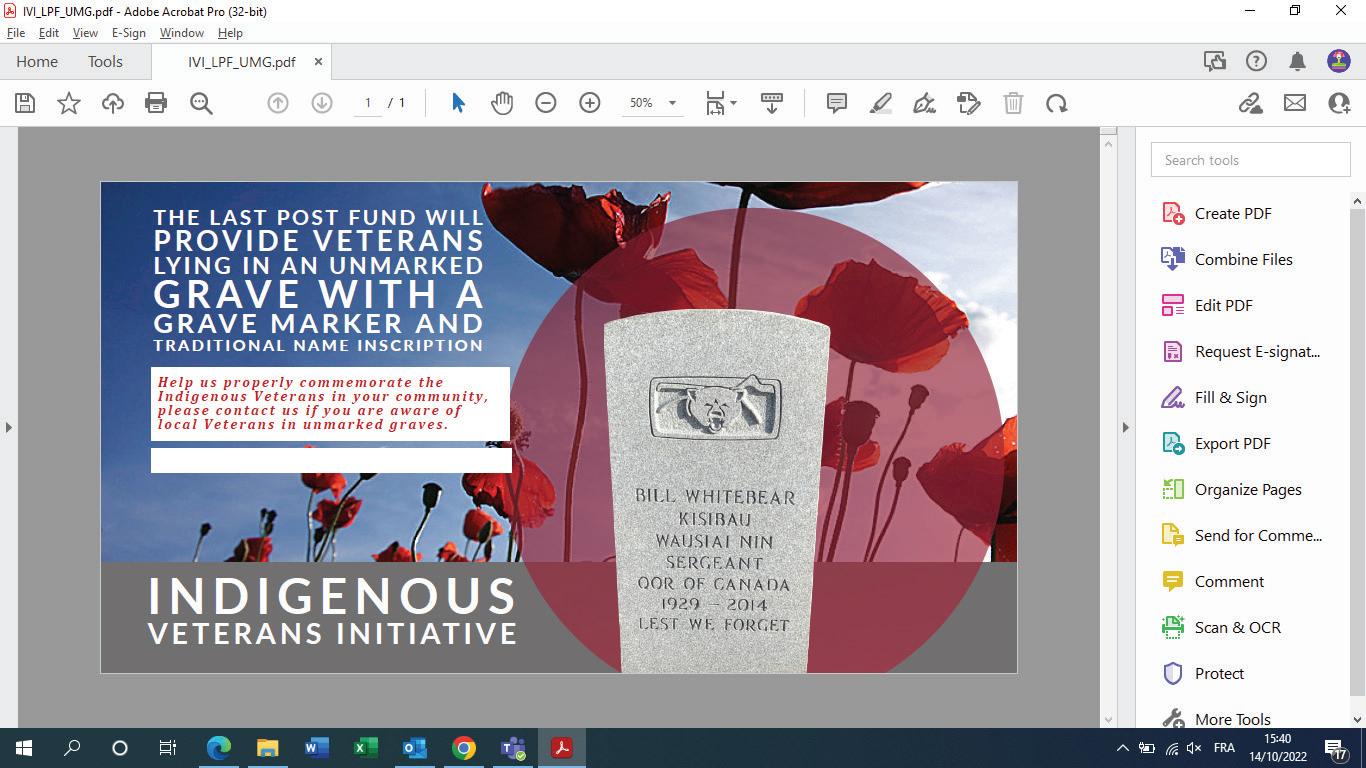




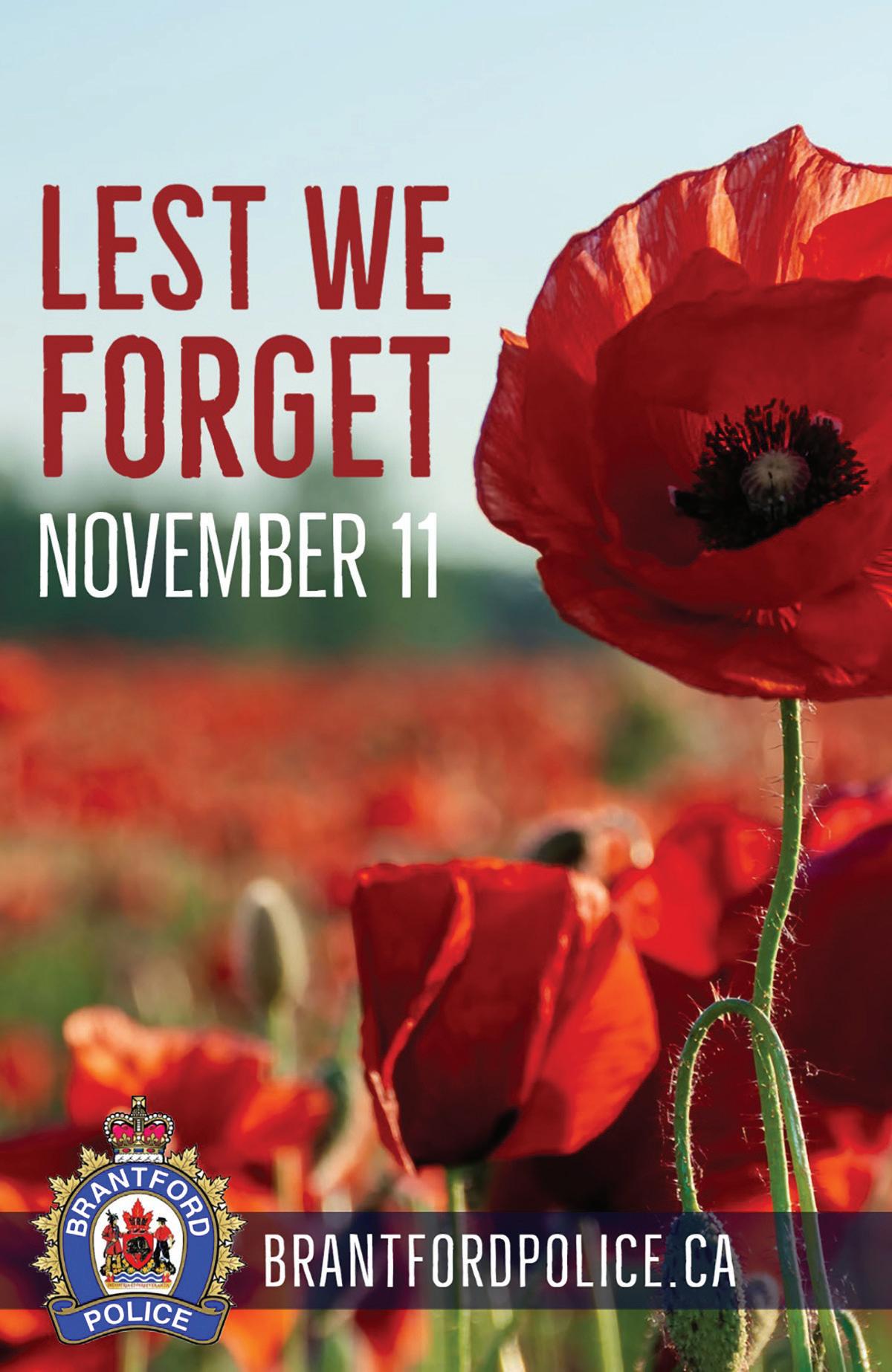






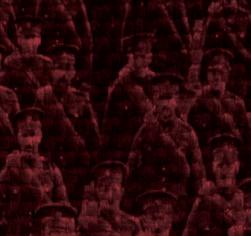






















Dental health is a key part of overall health and well-being and whatever your age, practising good dental hygiene and following healthy lifestyle habits is more important than ever during the pandemic.
Did you know there’s a link between dental health and diabetes? People with diabetes are at greater risk for dental problems like gum disease and infections that can make it harder to control diabetes. The good news is that treating either gum disease or diabetes can lead to improvements in the other!
To help keep your mouth in good shape:
• Brush and floss your teeth daily.
• Eat a balanced diet, rich in vitamins and low in processed sugar.
• Avoid or cut back on mouth-damaging habits like drinking pop or alcohol and smoking cigarettes, marijuana and vaping.
• Regular exercise and meditation can help reduce the impact of stress on your mouth and immune system.
For more dental care tips and what to expect at your next dental appointment, go to www.oda.ca.
Take time November 11th to pause and think of the freedoms we enjoy today because of the sacrifices made by all National and Aboriginal Veterans, The Royal Canadian Mounted Police, Allied Veterans, Serving, Retired, those who completed Basic Training and Honourably Released from The Canadian Armed Forces, and their families.

The Royal Canadian Legion, Ontario Provincial Command proudly supports all the above.
Do you know someone, in any of those categories, in need or who may qualify for Benefits?
Please contact us

Phone: 1-888-207-0939 or 1-905-841-7999
Email: rclontariocommand@on.legion.ca Website: www.on.legion.ca



Today and every day, we honour and give thanks for the bravery, sacrifice and service of First Nations, Métis and Inuit Veterans.








SIX NATIONS — Imag ine poking around the internet and discovering you are a direct descen dent of the founder of one of North America’s first Native activists organiza tions of the 20th century. Frederick Ogilvie Loft was the creator of an alliance of Indian (Onkwehonwe) Nations from across the country, known as the League of Indians, which eventually morphed into the Assembly of First Nations of today.
These are the revela tions Six Nations born Ironworker, Rope Loft, discovered while looking up another relative online, five years ago and it still has him floored.
Great-Great-Granddad Loft, and Ojibwa soldier Francis Pegahmagabow, most highly decorated Indigenous soldier in Canadian military history of World War I, used their positions to seek equal rights for “Indians Allies” who were serving in the military at the time. He is also one of the first reporters to alerted the world about the residen tial schools problems of abuse as early as the 1890’s.

According to author John L. Taylor, "F.O. Loft was undoubtedly a man born before his time. His resources were insuffi cient to sustain and en large the organization he envisaged. He was nearly sixty when he began and he had to maintain full-time employment to support his family. In any case, one person could not have done all that was required."
As it turns out, Rope’s great-great-grandfather was Lieutenant Frederick Ogilvie Loft, who served in the Canadian forces during WWI in the Forest ry Service, an extremely important service in Europe when war broke out on the Western Front. Shipping of raw building materials and tools for the war effort was being
curtailed by the German navy’s sinking of supply ships bound for Britain and the front.
Rope has only recently rediscovered his roots and after reading dozens of newspaper clippings from the early 1900’s and as many books as he could find about his famous relative, he expresses the pride he now feels in being in the lineage of one of the first political orga nizers for Native Rights across Canada.

When the war in Eu rope broke out, the call went out from Britain and France and their colonies for experienced forestry workers to fell trees, saw-millers to mill the lumber to erect field hospitals, clear paths for troop movement, airfields, line the hundreds of miles of underground trench es and tunnels for troop movement and sappers. Sappers were explosives experts but the worked closely with the tunnel builders, consisting of recruited miners and
lumbermen.
Sappers would dig miles long tunnels under the front lines of the German trenches, fill them with explosives and at a strategic time, detonate enormous explosions, lifting millions of tons of earth several feet into the air, killing hundreds of soldiers at a time and destroying forward machine gun and artillery positions.
The allies were not the only ones employing this subsurface warfare. The Germans were good at it as well. In fact there are some remaining reports and documents that told of Allide sappers actually hearing their German counterparts digging their own tunnels towards the British lines, only feet away.
Lieutenant Loft was well educated, spoke flu ent Mohawk and English and was a born leader, generally an impressive figure at 6’, at a time when the average hight for a man was 5’6”.
The Canadian Forest ry Corps was created on Nov.14th, 1916 and quickly became known under the nick-name, the "Sawdust Fusiliers", by the troops. The Canadian For estry Corps badge consists of a circle, with a beaver on top, superimposed on a pair of crossed axes, with the text "Canadian For estry Corps" around the edge. At the centre of the circle is a maple leaf with the Imperial State Crown.
The contribution Loft and these unsung heroes of the Great War made to the war effort can not be overstated, but was espe cially valuable during the trench standoffs in France and Belgium.
It was estimated by military planners at the time that every soldier needed five trees: one for living quarters, cooking and recreation; one for crates to ship food, ammu nition, tanks, and so on; and three for explosives, gun stocks, coffins, ships, factories, in support of the fighting on the front line.
The stretch of deep, sticky mud, blood, bodies and body parts littering the no-mans-land be tween Allied trenches and those of the German army made even walking a step a chore. The trenches had become cess pools of
disease and discomfort for months. More died of disease on both sides than were actually killed in battle.
The need for wooden planks and beams was great, to create some kind of flooring to walk on within these horrible trench conditions, as well as for building rudimenta ry underground barracks and war-rooms to plan strategies from.
It was all supplied by the “Sawdust Fusileers”, and without it, a person could easily be swallowed up in a death pool of mud and squaller, never to be seen again.
Lining the trenches and tunnels required massive amounts of materials as well. Every tree within a reasonable distance of the trenches was used up or reduced to riddled stumps by the incessant storm of lead going in both direc tions.
One-hundred years after the war, military archaeologists and local relic hunters are still finding tunnels which honey-comb almost all of France.
Today, the work of Loft and the other “Sawdust Fusiliers” usually goes unnoticed, but certainly not to the veterans of the “Great War” themselves.
They knew all too well that without them, the horrors of the tenches would have been far worse.
Loft did a lot of recruit ing work amongst the men of Six Nations and New Credit area, in advance of the war and during it. He also worked for a time as a reporter for the Brantford Expositor and the Toronto Globe and Mail.
His Mohawk name seemed to fit the tall, strong and handsome Frederick Loft well. His given Clan name was Onondeyoh: which means, “Beautiful Mountain.”
Rope Loft has a lot to be proud of. Although records of Indigenous sol diers in WWI are incom plete and were not well recorded, he has made it his mission to find out as much as he can about the life and times of his great-great-grandfather, Lieutenant Frederick Ogilvie Loft, activist and “Sawdust Fusilier.”
JACE KOBLUN jace@tworowtimes.com TWO ROW TIMESRemembrance Day in Canada and Veterans Day in the United States are celebrated annually in November to honour the many individuals who have served in each



country’s military. That figure is a sizeable one in the United States, as data from the Department of Veterans Affairs indicates there were around 19 mil lion U.S. military veterans in 2021.
Population estimates indicate that Canada has a little more than one-tenth the total population of its
immediate neighbour to the south, so the number of living Canadian veter ans is significantly smaller than it is in the U.S.
However, analysis of Vet erans Affairs Canada data estimates there were just under 618,000 veterans of Canada’s military in 2021.
The legacy of Leutenant Frederick Loft continued from page 18The Poppy has become the international symbol of remembrance for veterans killed in action. SUB







then.
Each year on November 11, Canadians pause in a silent moment of remem brance for the men and women who have served and continue to serve their country during times of war, conflict and peace. Known as Remembrance Day, the day honours the brave people who fought for Canada in the First World War (1914 to 1918), the Second World War (1939 to 1945) and the Korean War (1950 to 1953), as well as those who have served since
More than 1.5 million Canadians have served in the military. Tragical ly, more than 100,000 of those brave men and women have died.


The Canadian Armed Forces, or CAF, make up the government’s largest federal department. The CAF serves on land, in the air and on the sea, and branches include the Canadian Army, the Royal Canadian Air Force and the Royal Canadian Navy. Each branch serves a unique role. Learning about each branch is a great way for people to gain a greater under standing of the efforts and


sacrifices the men and women protecting their freedoms make each and every day.
Canadian Army: The largest element of the CAF, the Canadian Army is the land component of the country’s military. Soldiers in the Canadian Army are trained at bases, armouries and train ing centers throughout Canada. It’s these training sessions that prepare Ca nadian soldiers for a wide range of scenarios, includ ing operations at home and abroad. There are 23,000 full-time soldiers in the Regular Force and an additional 17,000 parttime, volunteer soldiers in
the Reserve Force.
Royal Canadian Air Force: The Royal Canadian Air Force protects Cana dian and North American airspace in partnership with the United States. The RCAF provides the Canadian Armed Forces with relevant, responsive and effective air pow er to meet present and future defence challenges. Among its many roles, the RCAF provides control and surveillance of Cana dian territory, airspace and maritime approaches while also conducting search and rescue mis sions to aid those in dis tress anywhere in Canada. Those are significant responsibilities, as Canada has the second largest territory and airspace in the world. The RCAF includes 12,000 Regular Force personnel and 2,100 Air Reserve personnel.
Royal Canadian Navy: The mission of the Royal Canadian Navy and its leader is to lead the strate gic development and gen eration of combat-capable, multi-purpose maritime forces while providing advice and support to maritime operations. The Maritime Forces Pacific, Maritime Forces Atlantic and Naval Reserve are directly responsible to the Commander of the Royal Canadian Navy. The Mar itime Forces Pacific and Maritime Forces Atlantic generate, maintain and sustain an armed capabil ity to guard Canada’s Pa cific and Atlantic maritime approaches. Maritime Forces Atlantic, which employs more than 5,000 military and 2,000 civilian personnel, is headquar tered in Halifax and home to 18 ships and subma rines. Maritime Forces Pacific, headquartered in Esquimalt, British Colum bia on Vancouver Island, is home to 15 ships and submarines and employs around 4,000 military and 2,000 civilian personnel.
SASKATOON — A report commissioned after con troversy circled a health professor's claims of being Metis says the Universi ty of Saskatchewan was unprepared for Indige nous identity fraud and uneducated on Indigenous people.
``Indigenous identity fraudsters have exposed the ignorance of USask with respect to Indigenous peoples,'' says the report by Jean Teillet released Thursday.
The University of Saskatchewan contract ed Teillet, a lawyer who specializes in Indigenous rights, to do an indepen dent investigation before health professor Carrie Bourassa resigned from her position earlier this year.
Bourassa was placed on leave and suspended from her duties as a professor in the College of Medi cinelast year, following a CBC report that her claims about being Metis did not add up.
Peter Stoicheff, the uni versity's president, said the report is not about Bourassa, because she is no longer an employee of the university.
``It looks that very dif ficult issue straight in the eye in a very useful way for the entire country,''
Stoicheff said.
The report says the is sue of Indigenous identify fraud is faced by univer sities and other institu tions across the country, which have long relied on self-identification. Some universities have commit ted to enhancing policies around Indigenous identi fication, including the Uni versity of Saskatchewan, University of Manitoba and Queen's University in Ontario.


It says universities did not anticipate and were not prepared for non-In digenous people trying to take advantage of oppor tunities created for their Indigenous colleagues.
And there was a general failure to recognize fraud sters and ignorance about how to identify Indige nous Peoples.
Teillet refers in the report to the cases of author Joseph Boyden and Michelle Latimer, a film maker and producer, who both had their Indigenous identities questioned in recent years.
The report lists red flags to help recognize Indigenous identity fraud, including conflicting stories, vague claims, repeated references to ceremony and claiming membership in a pan-In digenous organization. It also says family stories or secrets and a reliance on
stereotypes should raise concerns.
``This is not a proposal that the academy begin to police identity,'' the report says.
``It is a proposal that the academy educate itself about Indigenous iden tity fraud performance patterns and take steps to eliminate the fraudsters.''
The report says asking for verification evidence is not determining whether an applicant is Indigenous. It is putting in place a pro cess to ensure honesty.
Stoicheff said the report has recommendations for how the University of Saskatchewan should implement its new policy on Indigenous identity verification, which was put in place following the Bourassa controversy.
The policy, which was created by an In digenous-led group and approved in July, requires people to present evidenc eto support their identity if they are applying for employment or scholar ships. The university said it is asking Indigenous communities to determine what evidence is neces sary.

It has already faced criticism, with some people saying the docu ment-driven approach is colonial and can leave out Indigenous people who have been disconnected
from their communities by residential schools, adoption or the child-wel fare system. Others have said the policy creates a burden that could discour age Indigenous students from applying for scholar ships.
An Indigenous-led standing committee was created to help inform how the policy will contin ue to play out.
Airini, who goes by one name and is the University of Saskatchewan's pro vost and vice-president academic, said the policy was developed by and for Indigenous people. She said the report shows that while the road may be bumpy, it is going in the right direction.
``We are seeing that it's a confirmation that we are following good process,'' she said.
The report and its rec ommendations are to be provided to the standing committee to help shape the policy on identifica tion. It can also be used as a teaching tool for human resources and recruitment staff, Stoicheffsaid.
Stoicheff added that the reporthas important information for all univer sities that are looking to develop similar policies.
``This is an institution of learning and higher learning, and there is always a lot to learn.''
The Canadian Press
BARRE, Mass. (AP)
— About 150 artifacts considered sacred by the Lakota Sioux peoples are being returned to them af ter being stored at a small Massachusetts museum for more than a century.
Members of the Oglala Sioux and Cheyenne River Sioux Tribes traveled from South Dakota to take custody of the weapons, pipes, moccasins and clothing, including several items thought to have a direct link to the 1890 Wounded Knee Massacre in South Dakota.
They had been held by the Founders Museum in Barre, Massachusetts, about 74 miles west of Boston. A public cere mony was held Saturday inside the gym at a nearby elementary school that included prayers by the Lakota representatives. The artifacts will be offi cially handed over during a private ceremony.
``Ever since that Wounded Knee massa cre happened, genocides have been instilled in our blood,'' said Surrounded Bear, 20, who traveled to Barre from the Pine Ridge Indian Reservation, according to The Boston

Globe. ``And for us to bring back these artifacts, that's a step towards heal ing. That's a step in the right direction.''
The ceremony marked the culmination of repatri ation efforts that had been decades in the making.
``It was always import ant to me to give them back,'' said Ann Meilus, president of the board at the Founders Museum. ``I think the museum will be remembered for being on the right side of history for returning these items.''
The items being returned are just a tiny fraction of an estimated 870,000 Native American artifacts _ including nearly 110,000 human remains _ in the possession of the nation's most prestigious colleges, museums and even the federal govern ment. They're supposed to be returned to the tribes under the 1990 Native American Graves Protec tion and Repatriation Act. Museum officials have said that as a private in stitution that does not re ceive federal funding, the institution is not subject to NAGPRA, but return ing items in its collection that belong to Indigenous tribes is the right thing to do.
For Immediate Release: November 8, 2022

In October 2022, Six Nations of the Grand River’s Housing Department received just over $1.5 million in funding to go towards the construction of a 5 unit townhome on Harold Road in Ohsweken. This build is being conducted in partnership with Habitat for Humanity Hamilton and Habitat Heartland, with construction beginning this month and expected to be completed by Summer 2023.


The total cost of the development is $1,566,304.60, of which Six Nations Economic Development Trust contributed $1.06M, with $500,000 of additional funding coming from Housing’s 2020/2021 Indigenous Services Canada Enhanced funding allocation. The initial cost of the project significantly decreased due to Habitat’s involvement. This valued partnership has the potential to benefit the Six Nations community in future projects as well.
“It pleases me greatly to see our community agencies working together for the betterment of Six Nations,” said Elected Chief Mark B. Hill. “The generosity of the Economic Development Trust and the involvement of Habitat for Humanity strengthens our ability to provide safe, affordable housing so our people can continue to live in their home community. I want to say nia:wen to everyone involved in this effort and I look forward to the completion of this project next year and many more beyond it.”


For any community questions or concerns, please reach out to Lily Anne Mt. Pleasant, A/ Director of Six Nations Housing, at (519) 445 2235 ext. 6322 or hfco@sixnations.ca 30



Media Contact: Six Nations of the Grand River Communications Officer commsofficer@sixnations.ca 1695 Chiefswood Road, P.O. Box 5000, Ohsweken Ontario N0A1M0
The Canadian Press
MONTREAL — An Indig enous Quebec man who was denied car insurance because he lived on a reserve was the victim of race discrimination, the province's human rights commission concluded in a recent decision.
Alexis Wawanoloath, a lawyer and ex-Parti Quebecois member of the legislature, told a news conference Thursday he welcomed the decision stemming from a com plaint four years ago, but called it a partial win because the decision didn't look at the systemic nature of the situation.
``Yes, I experienced dis crimination, but as I knew it had been experienced by plenty of other people, I wanted the commission to look at the systemic issue,'' Wawanoloath said at the offices of the Centre for Research-Action on Race Relations, which

helped him with his com plaint.
Wawanoloath, 40, brought the complaint in October 2018 after he was refused a car insurance quote because of his post al code in Odanak, about 120 kilometres northeast of Montreal.
He said the minute he gave the postal code, the woman at the other end of the phone said that they could not insure him because the address was on the reserve.
The commission released a decision last month that found insur ance company Industrial Alliance was guilty of ra cial discrimination against Wawanoloath, a member of the W8banakiak First Nation.
The commission ordered the Quebec Citybased insurance compa ny to pay Wawanoloath $20,000 in moral and punitive damages.
1M0
know the score.
SIX NATIONS — The Iroquois Lacrosse Arena (ILA) is sporting a new arena floor within the Six Nations Community.

Combining colours of wampum, the age-old green base with new de sign symmetries, the floor was replaced by Novem ber 4 and the change had been a “long time coming.”
According to Arrows Express Sports, the original floor design was
a used turf installed back in 2004, making the ILA home of the former turf for 18 years.
On October 28 and 29, arena staff and help ers wearing boots and gloves, removed the turf and rubbed elbows with owner Curt Styres and
his son Brandon Styres. Fourteen rolls in total were removed with an ap proximate weight of 1200 pounds.
Turf Alliance, a compa ny leading in sports con struction, took the new turf in on October 31 and completed the installation
process last Friday, just in time for an NLL team to break it in.
The Halifax Thunder birds and Curt Styres opened the floor with their opening camp on Saturday, November 5, the same team that features Six Nations players such
as Cody Jamieson and Warren Hill on its roster.
The new floor will wel come the Six Nations com munity and visitors from now on, with multiple winter lacrosse avenues to come.
SIX NATIONS — An open letter for sponsorship was provided to the Six Nations community by the Six Nations Girls Field Lacrosse Association (SNGFLA) on October 24, detailing the reality of a sports association recov ering from the Covid-19 pandemic.
The SNGFLA has of fered girls the opportunity to learn and play field lacrosse for over 20 years within Six Nations and has grown from a single U-19 team, to many. The club has drawn players and families from Six Nations, Caledonia, Brantford, and other surrounding com munities and First Nation territories.
As many sports bodies within Six Nations rebuild their sports teams with younger, aged-in play ers, navigate the loss of
aged-out players, loss of referees and lack of avail able, certified coaches, the SNGFL is looking continue providing the opportunity to keep “young girls active and feeling included in a team environment.”
“The Covid-19 pan
demic has had a major negative impact on our organization. From losing players after not being able to offer teams for two summers, losing bench staff and board members due to personal circum stances, increased costs of
league fees, and of course the dreaded cost of gas and travel accommoda tions more recently,” reads the letter.
“To continue to grow and represent our com munity with pride, Six Nations Girls Field La
crosse is seeking a variety of donations. We want to ensure that our teams safely hit the field each summer with a certified bench staff, prepared trainer and all os the proper equipment to help them succeed. Most im
portantly, we hope to keep the cost of participating minimal so that as many female youth in the com munity can feel welcomed and included on a team of their own!”
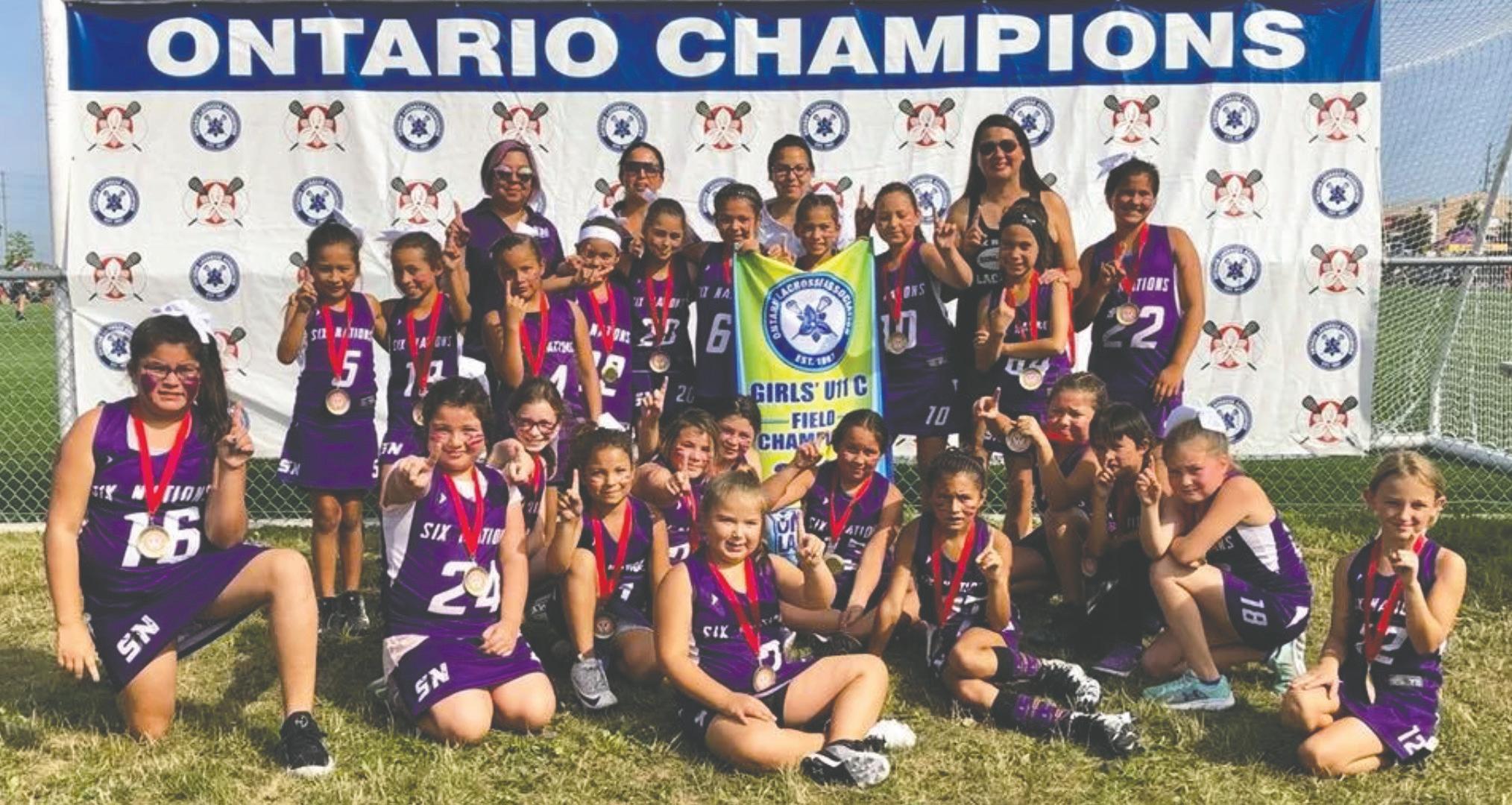
Prior to the pandemic, the SNGFL supported teams from the U-9, U-11, U-13, U-15, U-19 and senior women divisions, but in 2022, the organiza tion was only able to offer four teams. The organiza tion saw a lack of interest in the U-19 and senior division specifically and are hoping to recover with community support.
SNGFLA President Tawnie Powless, formerly Johnson, wrote to Face book: “Six Nations Girls Field Lacrosse will be sell ing tickets for a January Wellness Calendar soon, but first we are seeking sponsorships to help make this a success!”
It was noted that the more donations collected, the less registration fees for members will cost.
MANITOBA — The 2023 NAHC will take place May 7-13 at Seven Oaks Arena in Winnipeg, MB, and already, Alberta is gearing up its roster.
The Aboriginal Sport Circle established the Na tional Aboriginal Hockey Championships (NAHC) in 2002 to serve as the premiere competition for young Indigenous hockey players in Canada.


The annual event provides a forum for elite U15/ U18 aged Indige nous male and female youth and attracts partic ipation from First Nation, Inuit and Metis across the 13 provinces and terri tories. The event returns again after the Covid-19 pandemic and is hoped to help foster cultural unity
Indigenous players from across the country. The NAHC also serves as a focal point for grassroots and regional Indigenous hockey development.
One team in particular has already completed a selection process. Hockey Alberta, in partnership with the Indigenous Sport Council of Alberta, oversaw and coordinating the selection process for the players and coaches representing the province at the championships.
Bench staff and a roster were announced on November 1, after players attended the selection camp in August in Red Deer at the Gary W. Harris Canada Games Centre. The top 36 athletes were shortlisted for a camp on September 25.
Last year, the Team Ontario NAHC roster earned silver after a thrill ing game against Team
PHILADELPHIA – On November 7, the Na tional Lacrosse League (NLL), announced that it is renewing its pro tective equipment and apparel partnership with EvoShield.

A new two-year agree ment will see EvoShield continue as the NLL’s official supplier of per formance driven sports protective gear in the 2022-23 season. The deal continues a partnership that began in 2018, before the Covid-19 pandemic.
In August of 2022, EvoShield launched two new versions of Lacrosse Arm Guards featuring the brand’s proprietary GelTo-Shell technology that ensures a custom fit for every player.
EvoShield’s lacrosse offerings include slash guards, NOCSAE-approved should pads, lacrosse gear bags, mouth-guards approved by the American Dental Association, as well as men’s and wom en’s lacrosse uniforms. A new protective rib shirt that integrates into the Evoshield Shoulder pads for a lockdown fit will be released this winter.
EvoShield is cited as working closely with NLL players for insight in de velopment of its lacrosse
shield products to ensure the highest quality, com fort, and protection for players at all levels. Under the partnership, EvoShield will supply NLL athletes on every team with pro tective gear and apparel.
As for transactions, this past week saw much movement.
On November 7: the Al bany FireWolves released Luke Van Schepen from the Active Roster. The Hal ifax Thunderbirds placed Justin Martin, Colin Hinton on the Physically Unable to Perform List from the Active Roster. The Hali fax Thunderbirds placed Austin Shanks, Brayden Hill on the Hold Out List from the Active Roster.
The Halifax Thunderbirds placed Kealan Pilon on the Injured Reserve List from the Active Roster. The Hal ifax Thunderbirds signed Marty Hill, Kevin Hill, Darris Anderson, Riley Johnson, and Tyler Brown to one year agreements.
The San Diego Seals released Jacob Dowell from the Active Ros ter. The Toronto Rock placed Chris Corbeil on the Injured Reserve List from the Active Roster. The Toronto Rock placed Jason Noble on the Hold Out List from the Injured Reserve List. The Toronto Rock signed Zach Manns to a three year agreement. The Vancouver Warriors
placed Ethan Woods, Aidan Solomon, Brandon Goodwin, Ryan Martel on the Injured Reserve List from the Active Roster.
The Vancouver Warriors placed Tyrell Hamer-Jack son, Anthony Kalinich on the Active Roster from the Injured Reserve List.
The Vancouver Warriors placed Connor Goodwin on the Active Roster from the Physically Unable to Perform List. The Van couver Warriors released Mason Pynn, Dylan Robin son, Nick Preston, Dallas Wade, Cal Slade and Gord Phillips from the Active Roster.














On November 4: the
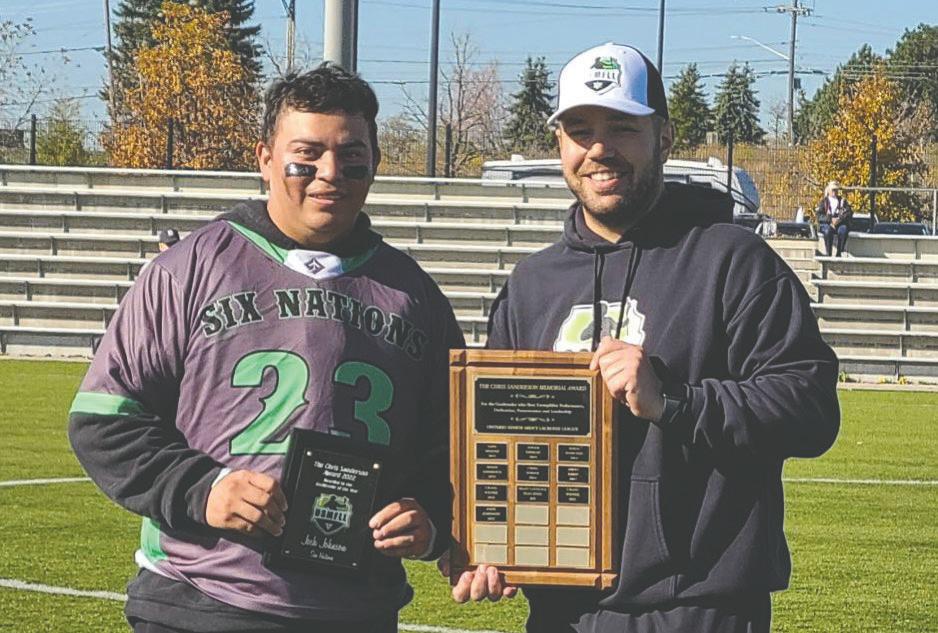
Albany FireWolves signed Jack Jasinski to a one year agreement.
The Calgary Rough necks signed Eli Salama, Tyler Pace, Shane Simpson and Tanner Cook to one year agreements. The Las Vegas Desert Dogs signed Charlie Bertrand to a one year agreement.
The Panther City Lacrosse Club released Ronan Jacoby, James Whiteford and Spencer Milne. The Panther City Lacrosse Club placed Liam Byrnes on the Active Roster from the Hold Out List. The San Diego Seals placed Matt Boissonneault on the Active Roster from
the Physically Unable to Perform List. And the San Diego Seals placed Danny Logan on the Physically Unable to Perform List from the Hold Out List.
Footcare
Executive
School
Administrative
Caretaker
Caretaker
Special
Sanitation
Speech
Child and Youth Health, Health Services Full Time TBD November 16, 2022
Personal Support Worker Full Time Personal Support Services, Health Services Full Time $21.00/ Hour November 16, 2022
Personal Support Worker Part Time Personal Support Services, Health Services Part Time $21.00/ Hour November 16, 2022
Education Manager Education, Central Administration Contract $70,000 to $90,000 November 16, 2022
Academic Lead Education, Central Administration Contract $65,000 to $75,000 November 16, 2022
Wildlife and Stewardship Management Assistant Lands and Resources Full Time TBD November 16, 2022
Personal Support Worker Iroquois Lodge, Health Services Full Time $22.00/ Hour November 16, 2022
Administration Lead Administration, Health Services Contract $75,000 to $82,500 November 16, 2022
Cook Child Care Services, Social Services Full-Time $20.00/ Hour November 16, 2022
Cook Iroquois Lodge, Health Services Part Time TBD November 16, 2022
Maintenance Worker Iroquois Lodge, Health Services Part Time TBD November 16, 2022
Ęsadatgęhs Quality Lead Administration, Health Services Full Time TBD November 16, 2022
Acting Housing Director Housing Contract $95,000 to $110,000 November 16, 2022
Activity Assistant Iroquois Lodge, Health Services Full Time $21.00/ Hour November 16, 2022
Community Support Worker Family & Community Wellness, Health Services Contract $21.00/ Hour November 16, 2022
Support Staff Child Care Services, Social Services Full Time $18.00/ Hour November 16, 2022
Dementia Care Team-Elder Companion Home & Community Care, Health Services Part Time TBD November 23, 2022
Registered Early Childhood Educator Child Care Services Social Services Full Time TBD November 23, 2022
Community Standards Coordinator Justice, Central Administration Contract $60,000 November 23, 2022
Early Childhood Educator Child Care Services (Clarence
Special
Occupational
Admission/Concession
Behaviour
Facilitator (RECE) EarlyON Child and Family Program Mississaugas of the Credit First Nation
Contract $20.66 to $29.14/ Hour November 10, 2022
Child Care Assistant Mississaugas of the Credit First Nation Full Time/ Permanent $32,953.50 to $45,805.50 November 10, 2022
Educational Assistant Mississaugas of the Credit First Nation Contract $18.80 to $26.33 / Hour November 10, 2022
Casual Handyman Mississaugas of the Credit First Nation Casual/ On-call $15.55/ Hour November 10, 2022
Cultural Awareness Coordinator Mississaugas of the Credit First Nation Full Time/ Contract $40,250 November 10, 2022
Request for Proposal
Assistant Registrar
Grand River Employment and Training Contract TBD November 17, 2022
Six Nations Polytechnic
Full Time/ Contract TBD November 17, 2022
Human Resource Manager Mississaugas of the Credit First Nation Full Time/ Permanent $51,313.50 to $73,346.50 November 17, 2022
Beyond the Bell Supervisor YMCA
Part Time $18.50/ Hour November 18, 2022
Beyond the Bell Educator YMCA Part Time $16.25/ Hour November 18, 2022
Beyond the Bell Casual Educator YMCA Casual $16.25/ Hour November 18, 2022
Guidance Counsellor
Welding Instructor
Six Nations Polytechnic
Six Nations Polytechnic
Full Time TBD November 18, 2022
Full Time/ Contract TBD November 19, 2022
Construction Teacher Six Nations Polytechnic Full Time/ Contract TBD November 19, 2022
Music Teacher Six Nations Polytechnic Full Time/ Contract TBD November 20, 2022
Development Officer – Institutional Advancement Six Nations Polytechnic
Full Time TBD November 25, 2022
Supply Teachers Kawenni:io/Gaweni:yo On-call TBD November 25, 2022
Six Nations Cannabis Commissioner Six Nations Cannabis Commission B.O.D. TBD December 1, 2022
Lab Technician and Developer Six Nations Polytechnic Part Time TBD Until Filled Weekend Visitor Services Woodland Cultural Center Part Time $18.00/ Hour Until Filled
Kanien’kehá:ka Teacher Assistant for Kawenni:io/Gaweni:yo
Full Time TBD Until Filled Elementary Classroom Positions
English/ESL Teacher Kawenni:io/Gaweni:yo
Full Time TBD Until Filled
Construction Staff Six Nations of the Grand River Full Time/ Permanent $18.00 to $20.00/ Hour Until Filled Development Corporation
Cook Mississaugas of the Credit First Nation Casual $16.90/ Hour Until Filled IT Technician Ohsweken Speedway Full Time/ Permanent $45,000 to $75,000 Until Filled Kitchen Help Sade:konih TOJ TBD Until Filled Cashier Styres Gas Bar Part Time TBD Until Filled Weekend Visitor Services Woodland Cultural Center Part Time $15.00/ Hour Until Filled Housing Outreach Worker Brantford Native Housing Full Time TBD Until Filled Tire Technician Hills Tire Full Time TBD Until Filled Chiefswood Park Food Truck Cook Six Nations of the Grand River Full Time/ Seasonal $18.00 to $20.00/ Hour Until Filled Development Corporation
Project Administrative Assistant Woodland Cultural Centre Full Time TBD Until Filled Operations Manager Kayanase Full Time TBD Until Filled Forestry Labourer Kayanase Summer Student TBD Until Filled Ground Maintenance Worker Kayanase Summer Student TBD Until Filled Gas Bar Attendant Mississaugas of the Credit First Nation Part Time TBD Until Filled Park Attendant Six Nations of the Grand River Full Time/ Permanent $18.00 to $20.00/Hour Until Filled Development Corporation
Bingo Hall Cook Six Nations of the Grand River Full Time/ Permanent
August 12, 1964 - November 8, 2022


It is with heavy hearts that we announce the passing of our beloved Karen. With her hubby, Lynn, by her side, Karen embarked on her journey home to be reunited with her beloved daughter Melissa (Orpha) and parents ‘Lizzie’ and ‘Shelby’. Survived by her loving husband of 35 years, Lynn Travis, children Nicole (Haoyadihoh) and Shelby; grandchildren Lance, Shailee, Taylor, Carlynn, Tylea and Brantley, and greatgrandson Chauncey; Siblings Dorie (Bill), Johnny, Dave, Laura and Anthony (Connie), auntie Sandra and Brenda, and uncle Junior (Kathy). Also survived by many nieces, nephews, cousins and friends around the world. Resting at the homestead, 3327 5th line, Ohsweken after 6pm on November 9th where Funeral Service and Burial to follow on Friday, November 11, 2022 at 11am. Arrangements by

Bomberry: Carol Yvonne July 10, 1957 - November 5, 2022

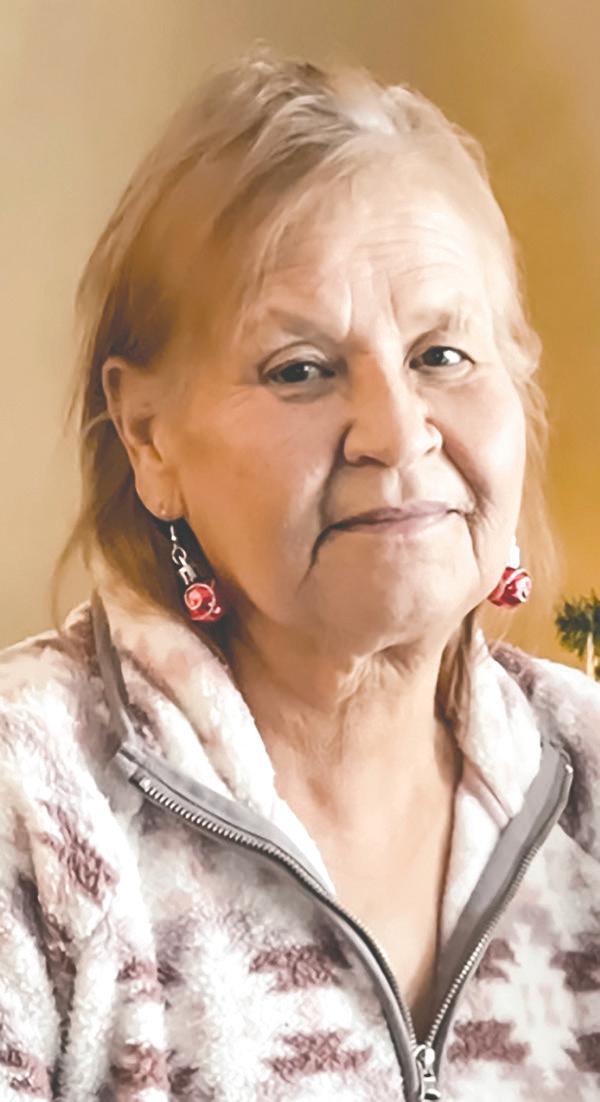
It is with broken hearts the family announces the passing of our loving mom and grandma Carol Yvonne Bomberry. Loving partner of Richard VanEvery. Cherished mother of Shanna (Clay), Shelley (Trevor), Shawn (Avery), Sherri (Trevor), and Shane. Devoted Grandma of Shelton, Chloe, Kaysha, Kale, Kahn, Dominique, Elan, Claudia, Marissa, Gavin, Grant, Breezie, Layney, Trenton, Ty, Sugar - Bear (Kayley), Trevin, Shadow (Kyley), Keyah, Halle, Brenz, Brayden, Jarrod, and A.J. And great grandma of 6. She is also survived by her sisters Wendy (Ladd), Teresa (late Ellis), brothers Larry (Linda), Graham, and Scott. She is also survived by many nieces, nephews, & cousins. She is predeceased by her grandsons Tyler and Taters, parents Fred and Blanche Hill, son Tone, and sisters Deb and Irma.
Resting at Styres Funeral Home, 1798 4th Line, Ohsweken after 10 a.m. Monday. Evening Service 7 p.m. Monday. Funeral Service will be on Tuesday November 8, 2022 at 1 p.m. Cremation to follow. www. rhbanderson.com
JACOBS: James Daniel “Jimmy” October 19, 1959 - November 5, 2022
Due to a short illness of cancer on Saturday, November 5, 2022, surrounded by loved ones James Daniel Jacobs (Jim) lost his fight. Beloved partner Robin Hill (my sweet little sugarcube) he liked to call her, she called him (sweetie Pie Jim). Father to SueAnn (Leo), and Daniel.

Loving Duda to Halie, Julia, Alana, Kay-Kay, Dustin, and Jacob. Great grandfather of Belle, Jaxon, Zarah, and Leenah. Survived by siblings Pete, and Donna (Rick). Also survived by many nieces, nephews, and cousins. Predeceased by siblings Gilbert, Jack (Pat), and Doris; and parents Harvey & Minnie. Resting at the homestead 7557 Townline Rd., Wilsonville after 12 noon on Tuesday where funeral service will be held at the house on Wednesday, November 9, 2022 at 11am. Interment to follow at Hill’s Family Cemetery. Arrangements by Styres Funeral Home, Ohsweken. www.rhbanderson.com

Suddenly passed away at home with his loving daughter by his side on Monday October 31, 2022 at the age of 57 years. Loving father of Kristina, and Josiah. Dear grandpa of Bella, and Cynthia. Son of Joyce (Hill) Davis (deceased), and Philip Davis Sr. Step-son of Kelly Davis. Brother of Phil, Ken, Audrey (Bruce), Brenda (Bill), Guy (Joanne), Fran, Shawn, Dawn (Chris), Matt, Dolly-Ann (Andy). Al will also be missed and always loved by numerous extended family and friends. The family will honour his life with visitation at Styres Funeral Home, 1798 4th Line, Ohsweken on Friday from 7-9 pm. where funeral service will be held on Saturday, November 5, 2022 at 1:30 pm. Interment Stumphall Cemetery, followed by a reception at Yogi’s Barn, 2318 Chiefswood Rd., Ohsweken. www.rhbanderson.com

has resumed open meetings starting Sunday, 20 November 2022 at 1-3 pm. All Welcome.
We are planning for a Border Crossing Celebration on Saturday, 15 July 2023. Members and volunteers needed.
